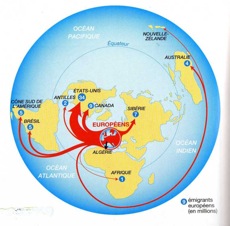3. Where do immigrants to the US come from?
3a. A map of European migrations in the 19th century
 Click image to enlarge
Click image to enlarge
3b. A table indicating the native country of immigrants between 1850 and 1930
3c. The geographic origins of immigrants to the US from 1900 to 2000
 Click image to enlarge
Click image to enlarge
Questions
Presentation and analysis of the historical context
At the beginning of the 19th century, the US population amounted to five million inhabitants of which 20% were slaves of African origin. Among the white, more than 60% were English. The huge migratory movements that started in the middle of the 19th century and lasted until the 1920s involved a considerable flow of populations. The massive character of European migrations to the “new world” has to be associated with the dynamic demographic growth of Europe whose population increased from 180 million of inhabitants in 1800 to 480 million in 1914, despite the emigration of more than 50 million people. Given the uneven distribution of proceeds of economic growth, cyclical crises, and severe exploitation, the emigration to new countries offerred millions of Europeans hope to escape poverty and even starvation, as was the case of hundreds of thousands of Irish people. The other reasons for emigration of the Europeans were: to escape political repression targeted at the opponents of authoritarian regimes or persecutions that religious and ethnic minorities suffered from. “But apart of these general reasons, it mustn’t be forgotten that these are individuals that make their decision... because emigration is not only an escape, but also a new beginning. This huge movement to the US happened because on-site conditions were suitable for the growth of population: they had to build railroads, dig canals, explore new lands and develop industry... New states and railway and road companies such as cruise lines all send a single message: ‘we need settlers and passengers’.” (Nancy Green, L’odyssée des émigrants et ils peuplèrent l’Amérique, Découvertes Gallimard, 1994).
From the late sixties, the liner that replaced sailing vessels shortened considerably the time of traveling: at the beginning of the 19th century, crossing lasted around 35 days, which dropped to 15 days at the beginning of the 20th century. Moreover, the development of the rail network in Europe contributed to increase of the transatlantic migration. After banning the slave trade, the ship owners sought to fill in their ships. “Until the middle of the century, emigrants travelled in converted freighters. In 1850, when the emigration became stable, we began to design ships for the transport of passengers. Finally, at the end of 1860, sailboats disappeared and were replaced with bigger, faster and cheaper ships...” (Nancy Green, op. cité)
One of the characteristics of the evolution of immigration between 1850 and 1930 was the change of the geographical origin of the main migratory flows: in 1850, the immigrants came from northern European countries (Ireland, German states, the Great Britain); in 1910, they came predominantly from Italy and Russia. This migratory movement declined after the First World War for several reasons: casualties during the conflict, the need of labour force to reconstruct the countries and their industries, restrictions on immigration (Quota Act of 1924) or emigration.
By receiving 34 million of European immigrants in the 19th century, the US attracted more than a half the 67 million of Europeans who emigrated in the 19th century. All in all, America, with 55 million of European immigrants, attracted more than 80% of all Europeans who have emigrated. (cf. doc A – Question 1)
In 1850, 308 323 Europeans, including 164 004 Irish people, emigrated to the US.
In 1910, 926 291 Europeans, including 215 737 Italians. emigrated to the US.
Between 1850 and 1910, we notice a strong increase in the number of European immigrants to the US (x3). The decade 1901-1910 marks the apogee of European migrations to the US (1907 was a record year). In 1850, the Irish (164 004) and the British (51 085) immigrants represented 2/3 of European immigrants. In 1910, Italians (215 737) and those who left the Russian Empire (186 792) were the largest group of immigrants, but there were still 69 941 British people who emigrated to the US, which was more than in 1850. (cf. doc B – Question 2)
Between 1901 and 1910, 8 130 000 European emigrants migrated to the US. These were the Latin Americans and the Canadians (3.7 million) who were the largest group of migrants between 1991 and 2000. Summing up, there were three main areas where the immigrants came from between 1991 and 2000ł this shows that with at least 7.2 million of immigrants during the decade, the US remained a country of mass immigration. (cf. doc C – Question 3)





Presentation
The European population increased from about 180 million people in 1800 to over 480 million in 1914, despite the emigration of more than 50 million people. The United States, have become the primary destination for emigrants. The European emigration became especially massive in the late nineteenth and early twentieth century. Since the beginning of the twentieth century, many Europeans emigrating to the United States has declined considerably. However, this country remains at the end of the twentieth century, a country of mass immigration.